Kitesurfing in the USA: Gear, Techniques, and Spots

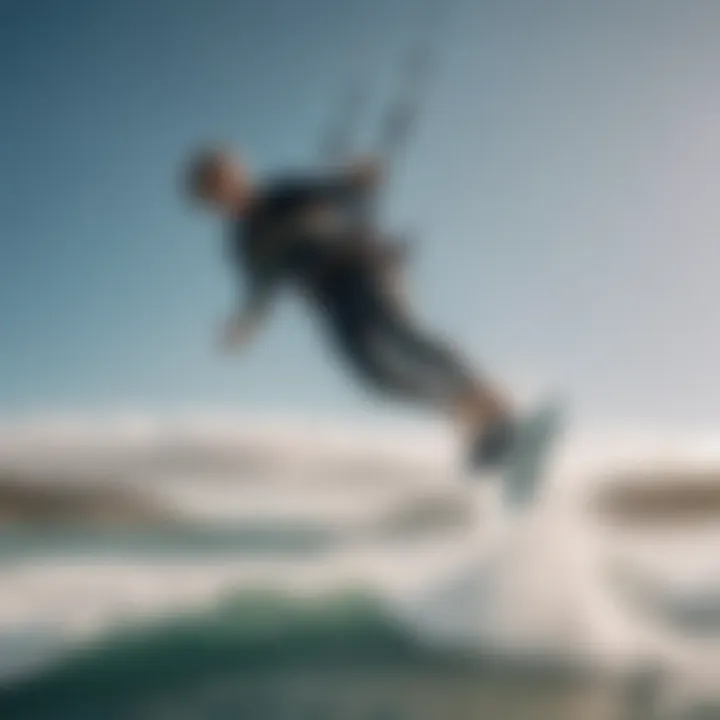
Intro
Kitesurfing, a thrilling blend of surfing, paragliding, and windsurfing, has steadily risen in popularity across the United States. As it captures hearts, numerous enthusiasts take to the water, eager to ride the waves and master the winds. This sport offers more than just adrenaline; it’s a lifestyle, a community, and an exploration of coastline wonders. The chapter ahead aims to guide both the fresh faces and seasoned riders through the essential techniques, vital gear, and diverse destinations where kitesurfing flourishes.
The beauty of kitesurfing lies in its accessibility. Whether you're a novice taking your first steps or a veteran pushing your limits, there’s always room for improvement and new experiences. Kitesurfing not only builds physical skills, but it also creates bonds among those who share a love for water and wind. This article will delve into the nuances that make kitesurfing such an exhilarating pastime and elaborate on practical considerations for safety, passion, and gear.
So buckle up; we'll explore the intricate world of kitesurfing, discussing everything from the right equipment to the must-visit spots that every kitesurfer should add to their bucket list.
Gear Essentials
Having the right equipment is paramount in kitesurfing; it not only ensures safety but also enhances performance and enjoyment. Deciding on kites and boards can seem daunting due to the plethora of options available. Let’s break it down to the essentials.
Top Picks for Watersports Equipment
- Kites: A key component, kites come in various designs and sizes. Liquid Force and Naish are popular choices among enthusiasts. These brands cater to diverse wind conditions and rider preferences. For beginners, a larger kite like the 12m size helps catch more wind without overwhelming a new rider.
- Boards: The choice of board can significantly impact your kitesurfing experience. Look for a board that matches your skill level and style. The Slingshot Misfit is excellent for those just starting, while those with a bit more experience might favor the North Mono for its maneuverability.
- Harnesses: A well-fitting harness is crucial. Dakine offers options that prioritize comfort for long sessions, while Ion harnesses are known for robust support, especially when catching big air.
- Safety Gear: Don’t skimp on safety. A proper impact vest can provide additional protection, and helmets are essential in crowded waters. Brands like Prolimit have quality options that keep you safe without being overly bulky.
Maintenance and Care Tips for Gear
Taking care of your kitesurfing gear can prolong its life significantly. Here are a few tips:
- Rinse your equipment with fresh water after each session to remove salt and sand, which can cause wear.
- Store your kite deflated and rolled up to prevent creases, while boards should be kept out of direct sunlight to avoid UV damage.
- Check your lines and canopy regularly for any signs of wear or fraying.
Following these simple steps can keep your gear performing at its best, allowing you to enjoy many thrilling sessions on the water.
Techniques and Tips
Kitesurfing isn't just a walk in the park; it requires mastery of various techniques. Let's address some need-to-know skills for both beginners and advancing riders.
Beginner Tips for Each Watersport
- Take lessons from certified instructors to get a solid foundation. They can teach you the basics such as body positioning and kite control.
- Always check wind conditions prior to hitting the water–understanding how wind affects your kite is essential.
- Practice launching and landing your kite with a buddy. This will help you get familiar with the process and make it safer.
Advanced Techniques for Skill Enhancement
- Work on your transitions. Smoothly changing direction while keeping your speed is a game-changer in kitesurfing.
- Explore jumping and tricks. Start with simple jumps before escalating to more complex maneuvers, ensuring that you have the fundamentals down.
- Regularly film yourself during rides to analyze your technique. Watching your progress can reveal small changes that can make a big difference in performance.
As you delve into the world of kitesurfing, always remember that practice leads to progress. This vibrant community offers endless learning opportunities, and sharing tips with fellow kitesurfers can enhance both your skills and enjoyment.
"The sea is where you meet the wind, and the kite is merely the bridge."
Embrace the journey and prepare to ride the exhilarating waves of kitesurfing in the USA.
Prelims to Kitesurfing in the USA
Kitesurfing has taken the United States by storm in recent years, becoming much more than just a thrilling watersport. This introduction to kitesurfing within the USA serves to shed light on the ways this sport encapsulates a sense of adventure, community, and personal growth. Enthusiasts from coast to coast, whether seasoned pros or newcomers, are weaving it into their lifestyles, creating a rich tapestry of shared experiences and culture.
It involves a unique blend of skills that combines elements from surfing, windsurfing, and paragliding, making it an exhilarating challenge for anyone who dares to take it on. The benefits of exploring kitesurfing include outdoor fitness, sheer enjoyment of nature, and the rush that comes when mastering each technique. More than just a pastime, it fosters camaraderie among practitioners. Places such as the Outer Banks and Hood River play host to vibrant communities, hosting events and competitions.
Historical Context
Kitesurfing's roots trace back to the 1970s; however, its popularity surged in the late 1990s and early 2000s. Originally, the activity began as a source of transportation in various forms of wind propulsion. Early innovators crafted makeshift kites, but they lacked the technology and safety equipment seen today.
The development of specialized kites and boards has made kitesurfing accessible to many. The sport kept evolving, and soon, entire communities began to spring up around kitesurfing hotspots. These communities, alongside the growing availability of instructional courses, helped secure its place as a record-setting sport. It became more common, transforming from an obscure niche to a celebrated global endeavor.
Current Trends
In recent years, several trends have shaped the kitesurfing landscape across the United States. New techniques are continuously emerging as equipment innovates; this means kitesurfers are now trying out advanced maneuvers previously untouched. The level of professionalism in kitesurfing competitions is high, drawing participants and fans alike with events broadcast worldwide.
Meanwhile, there's a strong push towards sustainability in the kitesurfing community, with a growing awareness of the environmental impact of ocean sports. Organizations have begun to advocate for practices that minimize damage to marine ecosystems. As technology evolves, we see improvements not only in gear performance but also in safety innovations aimed at reducing injury. These trends reflect the maturing nature of the sport and its growing acceptance among a wider audience.
Essential Kitesurfing Techniques
When it comes to kitesurfing, mastering essential techniques is a fundamental stepping stone that can make the difference between a thrilling ride and an uncomfortable struggle. The objective here is to develop a set of skills that not only enhance performance but also heighten safety on the water. With kitesurfing, every movement is connected, and understanding the finer points of both basic and advanced techniques is crucial for anyone hoping to truly enjoy the sport.
Fundamental Skills
Stance and Balance
A solid stance and balance form the backbone of effective kitesurfing. Without proper alignment, the risk of losing control increases significantly. Most kitesurfers recommend a slight bend in the knees, feet shoulder-width apart, and body weight evenly distributed. This configuration allows for quick adjustments in response to shifting wind and waves. The key characteristic here is that maintaining a low center of gravity enhances stability, enabling smoother rides and better control, which is essential for beginners and experienced kitesurfers alike.
One unique feature of mastering stance and balance is the synergy it creates between the rider and the kite. For instance, when adjusting to wind changes, a kitesurfer needs to shift weight accordingly to respond effectively. However, while balance is beneficial, it's noteworthy that it demands continuous practice. Failing to do so might lead to inefficiencies, such as falling off the board or not leveraging the kite's pull effectively.
Speed Control
Speed control is just as vital, acting as the kitesurfers' throttle, so to speak. It largely dictates how the rider interacts with the wind, enabling graceful maneuvers or fierce bursts of speed. By learning to modulate the power in the kite through steering and body positioning, riders can maintain optimum speed even in unpredictable conditions. The key characteristic here is the ability to gauge wind strength and adjust accordingly, which can make anyone feel confident riding with varying wind intensities.
The unique aspect of speed control is found in the adjustments made immediately during the ride. Riders must know when to lean back and generate more speed or pull in to slow down. Balancing speed can aid in preventing crashes and improving performance. Yet, it can present a disadvantage if not executed correctly; poor speed control can lead to abrupt stops or gaps in momentum that disrupt the flow of riding.
Advanced Maneuvers
As kitesurfers become more experienced, the focus shifts toward advanced maneuvers. This step into heightened skill challenges opens a new realm in kitesurfing, where creativity meets technique.
Jumping Techniques
Jumping techniques are often seen as the crown jewel of kitesurfing skills. They require a delicate balance of timing, kite control, and body mechanics. A successful jump often begins with a gradual increase in speed before executing a controlled rise. The key characteristic of jump techniques lies in the synchronized movement from the rider and their kite; by pulling back on the kite just as they take off, riders can achieve impressive heights.
One unique feature of these techniques is that they create an exhilarating experience, drawing attention and admiration from both peers and onlookers on the shore. However, it comes with its own set of risks – improper technique can lead to hard landings or crashes, especially for those who attempt jumps too early in their kitesurfing journey.
Transitions and Turns
Transitions and turns form the rhythmic heartbeat of kitesurfing; they are less flashy than jumping but equally vital to maintaining flow and control. This maneuver involves changing direction while keeping your momentum, contributing significantly to a seamless ride. The key characteristic is learning to shift weight effectively during these maneuvers, which helps maintain balance and doesn’t disrupt the kite's power.
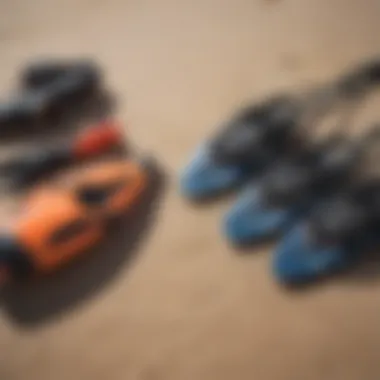
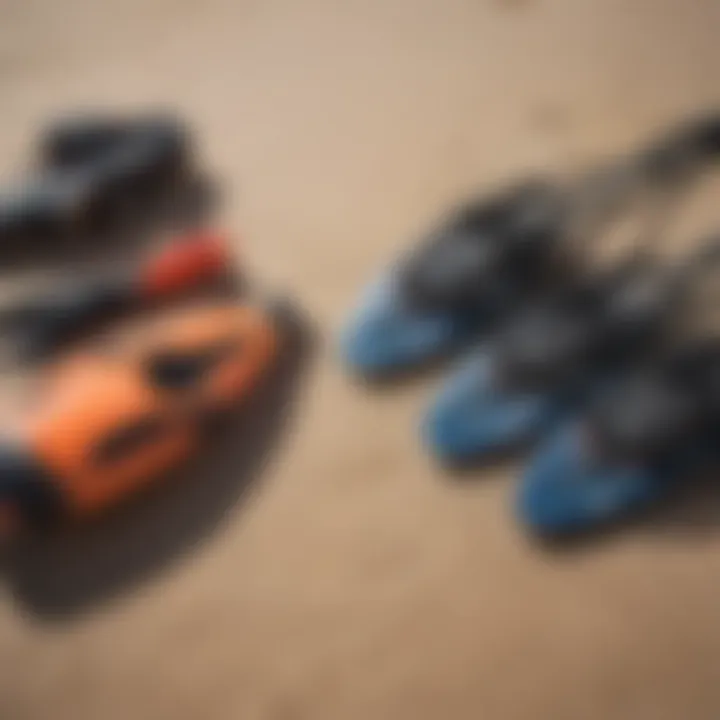
Transitions can be seen as an art form — a skill set that allows kitesurfers to showcase their mastery of the sport. One of the unique advantages of executing a well-timed turn is the ability to navigate different wind conditions effortlessly. On the flip side, without practice, these turns can go awry, leading to loss of speed or even potential wipeouts.
"Mastering essential kitesurfing techniques is not just about performance; it’s about enhancing safety and enjoying the ride."
In summary, engaging deeply with both fundamental and advanced techniques lays a robust foundation for success in kitesurfing. Whether it's perfecting a stable stance, controlling speed, or daring to jump high, each facet enriches the experience on the water and fosters a sense of achievement that resonates with kitesurfers of all levels.
Kitesurfing Equipment Overview
Understanding kitesurfing equipment is akin to deciphering the language of the ocean. It serves not just as a foundation for your experience on the water but also enables you to enjoy kitesurfing safely and effectively. Each piece of gear plays a pivotal role in how you interact with wind and sea. Whether you're zooming across waves in the Outer Banks or looking to perfect your technique in Hood River, selecting the right equipment is crucial for both performance and safety.
Types of Kites
Leisure Kites
Leisure kites, often seen fluttering in the breeze, cater to casual enthusiasts and beginners. One of the most significant aspects of these kites is their ease of use. Designed for stability and endurance, they allow kiteboarders to experience the joy of kitesurfing without overwhelming complexity.
Key characteristics of leisure kites include:
- Wider wingspan for increased lift.
- More predictable handling that is great for learning.
Leisure kites often come in a range of colors and patterns, appealing visually while functioning well in a variety of conditions. A notable advantage is their forgiving nature, allowing riders to recover easily from errors, making them beneficial for novice boarders. However, they may lack the speed and agility that advanced users would seek.
"Leisure kites are like your dependable bicycle; they get you where you need to go with fewer pretenses!"
Competition Kites
Competition kites are where the athletes come alive. Engineered for precision, speed, and performance, these kites embody the finest technological innovations in the sport. These kites tend to be lighter and more responsive, enabling experienced surfers to push the limits of tricks and speed.
The highlight of competition kites includes:
- Tailored designs that maximize aerodynamics.
- Varied shapes suited for specific styles, like wave-riding or freestyle.
A unique trait of competition kites is their ability to adapt to varied wind conditions. For advanced kitesurfers, this means they can excel in almost any environment, leading to exhilarating performances. However, the downside might be that these kites can sometimes feel less forgiving to newcomers, requiring skill and experience to wield effectively.
Boards and Accessories
Directional Boards
Directional boards are the choice when it comes to surfing downwind, allowing riders to gain a true surfing sensation. The specific aspect of these boards is their design, which generally features a pointed nose and a single fin. This structure enables maximum performance while riding waves, much like a traditional surfboard.
Key characteristics include:
- Efficient in handling waves and wind.
- Built with stability in mind, ensuring smooth rides.
The unique feature of directional boards is that they excel in carved turns and jumps. They are sought after for wave riding, giving the rider an edge in performance. However, they may not be as versatile when it comes to tricks, as the user cannot simply ride in both directions without a board switch.
Twin-Tip Boards
Twin-tip boards offer a different experience altogether. These boards allow for riding in both directions, facilitating easy transitions and tricks. A defining aspect of twin-tip boards is their symmetrical design, which doesn’t require the kitesurfer to change stance to traverse upwind or downwind.
Key characteristics include:
- Versatility in riding styles, making them ideal for freestyle maneuvers.
- Greater balance and control, particularly for beginners.
A unique feature of twin-tip boards is their adaptability, which allows riders to execute a stunning array of tricks, from spins to jumps. However, their performance may be less optimal in powerful surf conditions compared to directional boards.
By understanding the nuances of kitesurfing equipment, you’re better equipped to make informed decisions that will enhance your riding experience. Each piece of gear serves its purpose and, when combined with the right techniques and conditions, they create an exhilarating experience on the water.
Safety Considerations in Kitesurfing
When it comes to kitesurfing, safety isn’t just a checkbox; it’s the bedrock upon which thrilling experiences are built. Whether one is a seasoned pro or just dipping their toes in the water, understanding the safety aspects can save lives and ensure that the fun doesn’t turn into a nightmare. Not only does safety gear protect you from potential hazards, but understanding weather and tide conditions can significantly reduce risks. Having this knowledge at one’s fingertips can be the difference between a great day on the water and a harrowing experience.
Understanding Weather Conditions
Wind Patterns
Wind patterns are crucial in kitesurfing, as they determine how one navigates the water and interacts with the kite. Getting the hang of wind direction and speed is akin to learning the alphabet for a writer; it’s fundamental. For kitesurfers, onshore winds offer a safer experience, giving a steady pull with less chance of being blown away from the beach.
One important characteristic of wind patterns is their variability throughout the day. Winds can shift, often influenced by temperature changes. For instance, coastal areas frequently experience sea breezes that build later in the afternoon. Understanding these shifts allows kitesurfers to plan their sessions wisely, minimizing risks.
Yet, there are disadvantages as well. Sudden gusts can catch even experienced kitesurfers off guard, leading to accidents. It’s essential for riders to learn how to read the skies and gauge wind behavior to make informed decisions about when and where to ride.
Tide Effects
Tides play an equally critical role in kitesurfing. Not only do they affect water depth, but also how waves break, which can significantly influence a kitesurfing session. For example, riding during low tide may expose rocks or obstacles that can be hidden during high tide, creating unexpected hazards.
One key characteristic of tides is their predictability. With tools like tide charts, kitesurfers can check when the best conditions are likely to appear. This predictable nature means that one can plan sessions in the optimal conditions, enhancing safety and enjoyment.
However, there are drawbacks. Tides can create strong currents, especially in narrow channels or inlets, making it difficult to maintain control. Kitesurfers must always be aware of the tide schedule for their chosen location and prepare accordingly.
Safety Gear Requirements
Harnesses
Harnesses are a lifeline—quite literally—when it comes to kitesurfing. They connect the rider to the kite, allowing for a more efficient transfer of power while freeing up the arms for maneuvering. A well-fitted harness can alleviate strain on the back and distribute forces across the body effectively.
The characteristic versatility of harnesses is noteworthy. They come in various styles, such as seat and waist harnesses, catering to different riding preferences. This adaptability is crucial as it allows kitesurfers to choose based on comfort and the level of support they need.
However, if not properly adjusted, a harness can cause discomfort or even injury, emphasizing the importance of choosing the right fit.
Helmets
Helmets are often the unsung heroes of kitesurfing safety gear. They protect the head from potential impacts—be it from falling or hitting the water at high speeds. The primary characteristic of helmets designed for water sports is their snug fit and light weight, which encourages wear without being burdensome.
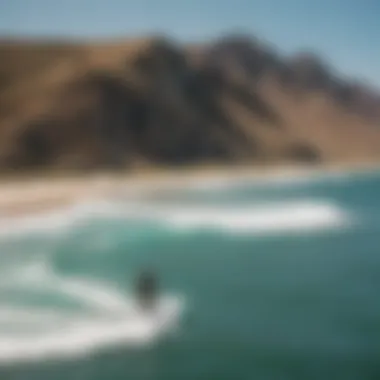
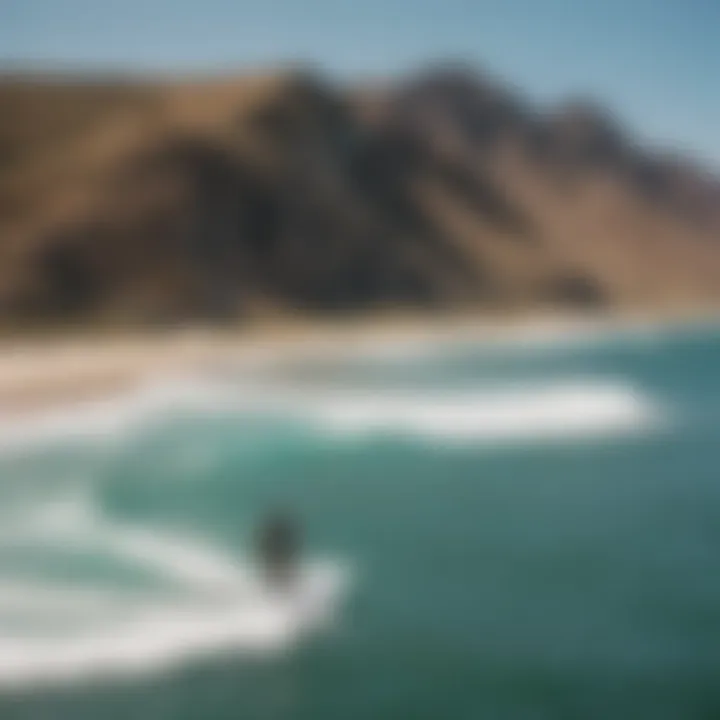
Additionally, some helmets come with features that enhance visibility and auditory awareness, such as sleek designs or even built-in communication devices. This ensures kitesurfers remain aware of their surroundings while enjoying their ride.
However, like any gear, helmets must be chosen wisely. Not every helmet is suited for kitesurfing, and using a general-purpose helmet may not provide adequate protection against the specific hazards encountered on the water. Therefore, investing in a specialized kitesurfing helmet is a smart move for anyone serious about safety.
In summary, safety should always be top of mind for kitesurfers. Understanding weather conditions is critical to avoid dangerous situations, while proper safety gear is essential for protecting oneself during rides. Keeping an eye on these elements will ensure that the thrilling experiences kitesurfing has to offer remain enjoyable and, most importantly, safe.
Top Kitesurfing Destinations in the USA
Kitesurfing isn’t just about the technique or the gear; locations play a vital role in shaping the experience. The United States is dotted with incredible spots, each offering unique conditions and quirks that kitesurfers cherish. From the windswept shores of the East Coast to the scenic vistas on the West Coast, exploring these kitesurfing destinations is essential for anyone wanting to enhance their skills and enjoy the thrill of the sport. Each location has something to offer—whether it’s steady winds, scenic backdrops, or a vibrant local community, these factors all contribute to making a destination a kitesurfing haven. Not only does this expose kitesurfers to diverse conditions, but it also provides opportunities to connect with fellow enthusiasts.
East Coast Hotspots
Outer Banks, North Carolina
Outer Banks is often cited as a mecca for kitesurfing enthusiasts. Known for its reliable winds and expansive shallow waters, it holds a unique charm for both beginners and seasoned riders. The area’s layout creates ideal conditions, making it a hotspot for learners who are still honing their craft. Moreover, the vibrant community here supports kitesurfing events and meet-ups, fostering a sense of belonging and camaraderie among practitioners.
One key characteristic of Outer Banks is its diverse landscape, encompassing everything from calm bays to challenging ocean waters. This variety allows kitesurfers to experiment with different styles and techniques. However, the unique feature of the location is the gradient of wind conditions; it can shift from friendly breezes to thrilling gusts, necessitating keen judgment from riders. Although it can get crowded in peak season, the open spaces often mean you can find a spot where you can ride with fewer distractions. Overall, experiencing kitesurfing in Outer Banks is undeniably advantageous for broadening one’s skills and enjoying the thrill of the sport in a supportive environment.
Miami, Florida
Miami stands as another prominent destination on the kitesurfing map, but it offers a different flavor. The crystalline waters and constant trade winds make it particularly appealing, providing perfect conditions almost year-round. Miami’s bustling beach culture adds a lively backdrop, making it more than just about the sport—it’s a lifestyle. Riders are drawn here not only to enjoy the waves but to soak in the vibrant energy of the locale.
The key characteristic of Miami for kitesurfing is the accessibility to multiple spots, each catering to different skill levels. From the calm lagoons favored by beginners to more challenging spots that seasoned riders take on, it caters to a wide audience. The unique feature here is the community events that regularly occur, creating an energetic atmosphere that inspires engagement and progression in the sport. On the flip side, the popularity of Miami as a tourist hotspot can occasionally lead to overcrowding on the beaches, putting a dent in the serene experience some may seek. Nonetheless, kitesurfing in Miami is a vibrant choice that combines sport, culture, and community into one thrilling package.
West Coast Best
Hood River, Oregon
Transitioning to the West Coast brings us to Hood River, which is celebrated for its consistent winds and stunning backdrop of the Columbia River Gorge. Hood River’s geographical features create a perfect scenario for kitesurfers, especially those looking to take advantage of river conditions. The river’s width and flow provide ample space for various maneuvers, attracting both novices and experienced riders who appreciate the continuous challenge.
One significant aspect of Hood River is how its seasonal winds create unique riding opportunities. The summer months bring reliable thermals, allowing kitesurfers to enjoy long sessions without interruption. The key characteristic of this location lies in its scenery; the breathtaking views of surrounding mountains add a picturesque quality to the kitesurfing experience. Still, while the conditions are mostly favorable, the river can present its quirks—changing currents that require constant attention. In terms of community involvement, Hood River boasts a tight-knit kitesurfing crew, often gathering for events that further enhance one’s skills. The advantages of kitesurfing here are plentiful, from the thrilling conditions to the supportive community.
San Francisco, California
San Francisco’s kitesurfing scene is nothing short of iconic, blending the bustling urban environment with stunning shoreline vistas. The city’s rich wind patterns create fantastic conditions for kitesurfers, making it a destination that successfully bridges urban and natural beauty. The variety of beaches, such as Crissy Field and Ocean Beach, adds different flavors to the kitesurfing experience; each spot offers unique challenges and opportunities.
The key characteristic of San Francisco is the cool coastal winds that sweep consistently across the bay, allowing for extended sessions. What sets it apart is the geographical influence—the currents can change quickly depending on the tides, allowing riders to experience a mix of conditions all in one day. Though the stunning views may seem inviting, it’s vital to remain cautious of the often-cold water and unpredictable weather factors. Nevertheless, the sense of adventure found in San Francisco is palpable, making it a sought-after destination. Emphasizing safety is crucial, but it ultimately adds to the exhilarating nature of the sport in such a dynamic environment.
In essence, each kitesurfing destination across the USA brings with it unique features and conditions that are integral to the sport. From the community vibrant in Outer Banks to the breathtaking landscapes of Hood River and San Francisco, these locations encourage growth, connection, and a fierce love for kitesurfing. They create an atmosphere where enthusiasts can truly thrive.
Gear Reviews and Recommendations
When it comes to kitesurfing, gear can make or break your experience. Selecting the right kite and board can enhance not only your performance but also your safety and enjoyment on the water. This section zooms in on the significance of reviews and recommendations on kitesurfing equipment, providing insights for both newcomers and seasoned pros.
Kite Reviews
Durability
Durability stands on its own as one of the critical features when choosing a kite. This aspect determines how long the kite can withstand the wear and tear of various weather conditions and rough usage patterns. A durable kite can often last multiple seasons, sparing riders the expense of frequent replacements. A kite constructed with reinforced materials and quality stitching can resist punctures and tears, significantly minimizing unexpected events that could sideline a rider.
A prime example of durability is the Cabrinha Switchblade, which boasts high-quality fabrics and carefully designed seams. Riders have found this kite to remain intact through tough storms, showcasing its strength.
However, the trade-off may be weight; while sturdier kites offer extended lifespan, they sometimes sacrifice a bit of nimbleness. Evaluating durability against specific riding conditions and personal style can lead to an optimal choice.
Performance
Performance is another key feature that affects the overall kitesurfing experience. A kite's performance covers speed, responsiveness, and the ability to handle various wind conditions. Riders seek kites that deliver reliable lift and stable tracking, allowing for smoother jumps and transitions.
Kites like the North Evo have gained popularity in this category due to their dynamic performance; they offer a balanced ride across various skill levels. Riders often point out the immediate responsiveness to steering and control, which enables swift maneuvers.
On the downside, performance kites can sometimes be challenging for beginners, as they might require a bit more technique to maximize their potential. So with performance in mind, understanding one’s level and goals is paramount when selecting a kite.
Board Comparisons
Beginner Boards
For those embarking on their kitesurfing journey, selecting a proper board becomes essential. A beginner board typically emphasizes stability and ease of use, allowing novices to focus on mastering the basics without overwhelming challenges. These boards often feature wider shapes and softer flexes, making it easier to ride in various conditions.
The Liquid Force Compact is a solid choice in this category. Its user-friendly design helps beginners find their footing, literally. Moreover, the board's forgiving nature can be a confidence booster, helping new kitesurfers to spend less time worrying about falls. However, some users may discover they need to upgrade sooner as their skills progress, a common scenario among those eager to advance.
Advanced Boards
On the opposite spectrum, advanced boards cater to more experienced kitesurfers keen on pushing their limits. These boards are generally lighter and designed with performance in mind. They facilitate high-speed riding and powerful jumps, allowing skilled riders to exploit their full capabilities.
The Slingshot Misfit often comes up in discussions among serious riders for its agility and performance-oriented design. Its unique features allow for top-notch grip and control, essential for those who wish to execute tricks and cuts in the water.
Nevertheless, such boards can prove difficult for novices who may find the heightened sensitivity and reduced stability daunting. As a result, it’s vital for riders to ensure they edge into advanced boards only after establishing a strong foundation of skills.
Kitesurfing Community Engagement
Kitesurfing isn’t just about the adrenaline rush of riding the waves; it’s also deeply rooted in the sense of community that surrounds it. Engaging with fellow kitesurfers offers a unique network of support, learning opportunities, and shared experiences. This camaraderie enhances the kitesurfing experience, enabling newcomers and veterans alike to build connections that are, metaphorically speaking, as steady as a well-worn kite string.
When it comes to engaging with others in the kitesurfing world, the benefits are manifold. One of the standout advantages is safety in numbers. Being part of a community means you have access to collective wisdom about local conditions and best practices. These insights can be invaluable, especially in areas prone to sudden weather changes or shifting tides. It also provides a platform for mentorship, where experienced kitesurfers can teach techniques to emerging talents, ensuring the tradition continues.
Furthermore, community engagement fosters a sense of belonging. Whether you’re at an event or a local spot, sharing the water with like-minded individuals who share a passion for the sport can turn an ordinary day into a memorable adventure. It's not just about kiting; it's about creating lasting friendships that often extend well beyond the water.
“The best part of kitesurfing is not just riding; it’s who you share the ride with.”
Local Clubs and Events
Joining a local club or participating in events can greatly enhance your kitesurfing journey. Clubs often organize meet-ups, competitions, and group lessons that cater to varying skill levels. This allows enthusiasts to mingle and exchange tips, tricks, and stories, making it easier to hone their craft in a supportive environment.
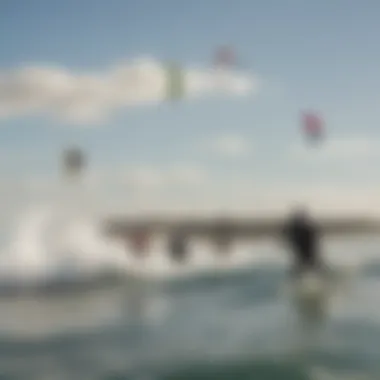
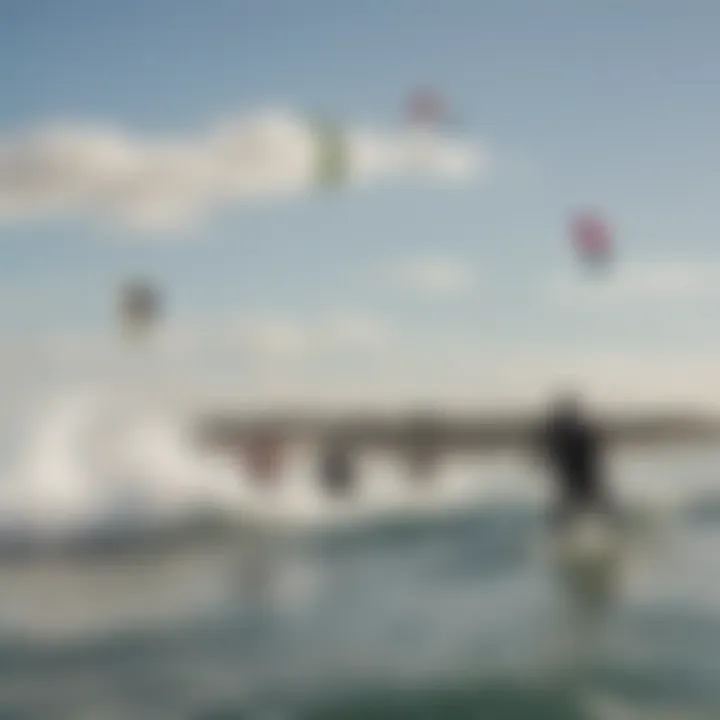
Every region has its local hotspots scheduling regular events and local competitions. For instance, in the Outer Banks of North Carolina, various clubs host competitions during peak season, attracting kitesurfers from near and far. This not only elevates the skill levels of participants but also showcases the vibrant local culture.
Here are some benefits of engaging with local clubs and events:
- Networking Opportunities: Make friends and become part of a larger kitesurfing family.
- Skill Development: From workshops on advanced techniques to beginners courses, clubs offer resources for all levels.
- Access to Equipment: Some clubs may provide equipment rentals or demo days, allowing you to try before you buy.
Online Forums and Resources
For those who may not have easy access to local clubs, online forums and resources serve as invaluable tools for engagement. Websites like Reddit and dedicated Facebook groups have become hotbeds for discussions about kitesurfing tips, tricks, and gear recommendations. These platforms bring together a diverse range of voices—from seasoned pros to eager novices—who can share their experiences and advice.
Communities on these platforms are more than just spaces for dialogue; they can also offer vital insights about travel, gear reviews, and safety measures. By participating in these discussions, you can keep your finger on the pulse of the latest trends and innovations in the kitesurfing world. Consider the following benefits of online engagement:
- Global Networking: Connect with kitesurfers around the world, broadening your perspective and knowledge.
- Learning Resources: Access to articles, videos, and expert blogs provides ample learning material for improvement.
- Shopping Tips: Members often share information about gear sales, giving you the chance to score some great deals.
Travel Tips for Kitesurfing Adventures
When it comes to kitesurfing, setting your sights on the right destination is just the tip of the iceberg. Having the proper travel strategies in place can make or break your experience. Travel tips for kitesurfing adventures are essential, not only for convenience but also for ensuring that you can seize the winds and waves to their fullest potential. Here, we will cover crucial details to consider, including packing essentials and how to transport your gear safely.
Packing Essentials
Before you hit the road or the skies, packing your gear correctly is paramount to a successful trip. Here are some must-have items you should include in your packing list:
- Kite and Bar Setup: Make sure you have the right size and type of kite suited for the local wind conditions. Don’t forget the control bar as well.
- Board: Bring either a twin-tip or directional board based on your preferred style and the conditions you expect.
- Safety Gear: Pack your harness, impact vest, and helmet. Safety equipment is non-negotiable, especially if you're heading to an unfamiliar spot.
- Wet Suit or Shorty: Depending on the climate, ensure your wetsuit is appropriate for the water temperature.
- Repair Kit: Always pack a basic repair kit that includes kite patches, a pump, and any essential tools for on-the-spot fixes.
To pack light but efficient, remember that less is often more; only take what you really think you'll use during your kitesurfing adventures.
It's advisable to roll your clothes to save space and prevent wrinkles. You can also use your snorkel or paddle gear as padding around more fragile items. A good organizer will save you the headache of rummaging through your backpack at the beach.
Transporting Equipment
Getting your equipment to your kitesurfing destination involves careful consideration. Transporting kites and boards can be tricky, and mishandling can lead to damage. Here are several tips to ensure your gear arrives intact:
- Invest in Quality Bags: A dedicated kite bag often comes with various compartments for better organization. Look for one with padding to give your gear extra protection.
- Check Airline Regulations: If flying, familiarize yourself with the airline’s policies on sports equipment. Additional fees or specific guidelines for larger items could add unexpected costs. Always weigh the bag before you leave home to avoid excess baggage charges.
- Use a Roller for Convenience: If you have multiple pieces of equipment, consider using a wheeled roller bag. These can make it easier to navigate airports and beach walkways, freeing up your hands for other tasks.
- Don't Forget Carry-Ons: Pack essentials like your wetsuit and a change of clothes in your carry-on. In case of delayed or lost luggage, being able to kitesurf without a long wait is a relief.
Environmental Impact and Kitesurfing
The connection between kitesurfing and the environment is a crucial aspect that deserves attention in any discussion about the sport. As the popularity of kitesurfing escalates across the United States, it's essential for enthusiasts to understand their role in maintaining the ecosystems they enjoy. These waters, beaches, and wind-swept landscapes are not just playgrounds; they are habitats that can be sensitive to the human footprint.
Sustainable Practices
Adopting sustainable practices can make a significant difference in how kitesurfers interact with their environment. Here are some suggestions:
- Minimize Waste: Always take your gear home. This means trash, broken equipment, and anything else you brought with you. Practicing the "leave no trace" philosophy keeps our beaches clean for others and protects marine life.
- Eco-friendly Gear: Opt for kitesurfing equipment made from sustainable materials. Certain brands now focus on producing environmentally-friendly products that lessen the ecological footprint of our sport.
- Responsible Launching: Launch and land your kite in designated areas to avoid damaging sensitive vegetation and delicate ecosystems. Recognizing these zones can help preserve local wildlife habitats.
- Participate in Clean-ups: Engage in community-led beach clean-ups. This not only helps the environment but also fosters camaraderie among fellow kitesurfers.
Conservation Initiatives
Several initiatives focus on mitigating the environmental impact of kitesurfing while promoting conservation:
- Local Organizations and NGOs: Groups like the Surfrider Foundation work tirelessly to preserve coastal ecosystems and advocate for clean water. Getting involved with such organizations can amplify efforts to protect the beaches and waters we love.
- Awareness Campaigns: Many kitesurfing communities run campaigns to educate riders about their environmental impact. This involves workshops on how to respect marine life and understand the biological importance of coastal areas.
- Beach Regulations: Some states have implemented specific regulations regarding kitesurfing to protect vulnerable environments. These regulations often involve seasonal access restrictions or designated zones for water activities. Understanding and abiding by these rules is essential for the sport's future.
"Every kite flyer has the ability to contribute to the conservation of our beloved natural spaces. It's about respecting the waves, winds, and shores while we ride them."
By being proactive and conscientious, the kitesurfing community can significantly contribute to preserving the delicate balance of our coastal ecosystems. It's not just about the thrill of riding the waves; it's also about safeguarding the future of the places that allow us to enjoy this incredible sport.
Future Trends in Kitesurfing
The world of kitesurfing continues to evolve, driven by advancements in technology and shifts in popular culture. Understanding these trends is paramount for both novice and seasoned riders wanting to stay ahead of the curve. The future is bright for kitesurfing enthusiasts, offering enhanced experiences and safety measures that were once thought to be mere fantasies.
Technological Innovations
When it comes to kitesurfing, innovation plays a critical role. Equipment manufacturers are always developing smarter, lighter, and more durable gear. For example, many kites now incorporate advanced materials that increase both performance and longevity. These materials help in reducing drag while maximizing lift, enabling riders to harness more wind power.
Furthermore, smart technology is making its way into kitesurfing. Devices like GPS trackers allow surfers to monitor their speed and distance traveled, helping them gauge their progress over time. Some even come equipped with waterproof heart rate monitors, providing insights into physical exertion levels while riding. This is real handy for those who want to train efficiently and push their limits.
Don’t overlook the merging of drones with kitesurfing as well. Drones can be used for filming from different angles and capturing those adrenaline-pumping moments. They also act as excellent tools for coaching, allowing instructors to analyze a student’s technique from above.
"The constant evolution of technology ensures no two kitesurfing experiences are ever alike. Riders all over the world share the thrill of pushing boundaries."
Evolving Kitesurfing Styles
The styles of kitesurfing are also undergoing transformation.
New trends have emerged, with freestyle and wave riding gaining immense popularity. Freestyle kitesurfers focus more on tricks, jumps, and maneuvers, pushing the limits of what is physically possible. In contrast, wave riders are being inspired by retro surf styles, emphasizing fluidity and grace rather than raw power.
Eco-heralds are changing the narrative as well. As awareness of environmental conservation grows, more riders are adopting sustainable practices. This includes using eco-friendly materials and participating in beach clean-up events, merging their passion for kitesurfing with a commitment to protecting the oceans and shores they cherish.
Kitesurfing is becoming more inclusive too. The community is working hard to create diversity within the sport, welcoming individuals from all walks of life. This shift is reflected in the increased representation in kitesurfing events, making the sport not just about individual achievements, but about camaraderie and shared experiences.
In summation, trends in kitesurfing reflect a dynamic interplay of technology, style, and community engagement. Embracing these changes is crucial for anyone wanting to fully enjoy what the sport has to offer.
Culmination
In this fast-paced world of kitesurfing, the conclusion ties together the key elements discussed throughout the article. It highlights the significance of mastering the various techniques, acquiring suitable gear, and selecting the right locations to practice this exhilarating sport. Each of these elements plays a vital role in enhancing not only the kitesurfing experience but also the overall safety and enjoyment of this dynamic watersport.
Summary of Insights
As we journeyed through the different aspects of kitesurfing, we uncovered a wealth of insights:
- Historical Context: Understanding where kitesurfing began provides depth to its evolution.
- Fundamental and Advanced Techniques: From proper stance and balance to executing advanced jumping maneuvers, each skill is essential for progression.
- Equipment Overview: Selecting the right kite and board can dramatically influence performance and enjoyment. The differences between leisure kites and competition kites paint a fuller picture of what’s available.
- Safety First: Grasping the nuances of weather conditions and mandatory gear like harnesses ensure that the fun doesn't come at a high risk.
- Destination Diversity: The East and West Coasts each offer unique settings that cater to every type of kitesurfer.
- Community Importance: Engaging with local clubs and participating in events enriches one's understanding and enjoyment of the sport.
- Environmental Responsibility: Implementing sustainable practices keeps the spirit of the sport alive for future generations.
With a deliberative assembly of practical knowledge, enthusiasts can now approach kitesurfing not just with enthusiasm, but with the skills and awareness necessary to enhance their journey.
Encouragement for Practitioners
To current and aspiring kitesurfers, here’s a call to action: Embrace the learning curve. Every expert was once a beginner, with tales of wipeouts and white-knuckled rides to share. Don’t shy away from asking for help when mastering new techniques or gear; seasoned kitesurfers are often eager to share their secrets and tips.
Stay engaged with the community, whether online or local. Platforms such as Reddit have vibrant discussions that cover everything from gear reviews to technique shares. Joining a local club provides an incredible opportunity to meet like-minded folks who share your passion.
Consider documenting your own journey, too. Keeping a log of your experiences can not only help you see how much progress you’ve made, but these stories can become sources of inspiration for others venturing into the kitesurfing world.
Remember, the beauty of kitesurfing lies not just in the stunts, but in the connections forged and the memories made on the water. Wherever your next ride takes you, ride the wind and savor every moment.



